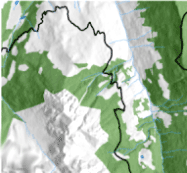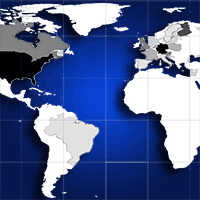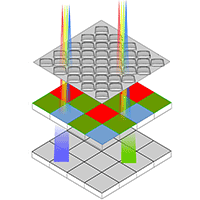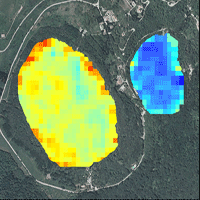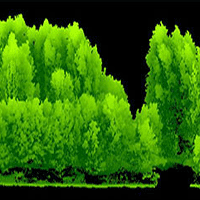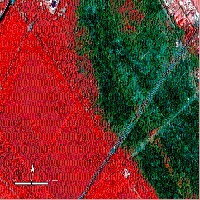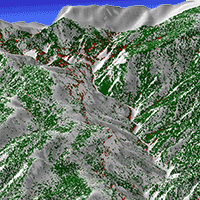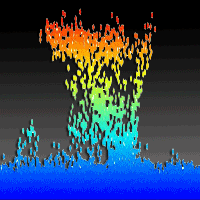Modeling of the spatial distribution of tree species based on survey data has recently been applied to conservation planning. Numerous methods have been developed for building species habitat suitability models. The aim of this study was to investigate the suitability of Pleiades satellite data for modeling tree species diversity of Hyrcanian forests in northern Iran (Mazandaran Province). One-hundred sample plots were established over an area of 2.600 ha and surveyed for tree diversity, and the Simpson’s index (D), Shannon’s index (H’) and the reciprocal of Simpson’s index (1/D) were calculated for each plot. Spectral variables and several parameters derived by texture analysis were obtained from multispectral images of the study area and used as predictors of tree diversity of sample plots. Two different methods, including generalized additive models (GAMs) and multivariate adaptive regression splines (MARS), were used for modeling. The results revealed a fairly good prediction of plot tree diversity obtained using the developed models (adj-R2 = 0.542-0.731). Shannon’s H’ and Simpson’s 1/D indices were more accurately predicted using GAM-based methods, while MARS models were more suitable for predicting Simpson’s D. We concluded that Pleiades satellite data can be conveniently used for estimating, assessing and monitoring tree species diversity in the mixed hardwood Hyrcanian forest of northern Iran.
Keywords
, , ,
Citation
Akbari H, Kalbi S (2016). Determining Pleiades satellite data capability for tree diversity modeling. iForest 10: 348-352. - doi: 10.3832/ifor1884-009
Academic Editor
Alessandro Montaghi
Paper history
Received: Sep 27, 2015
Accepted: Jul 18, 2016
First online: Nov 19, 2016
Publication Date: Feb 28, 2017
Publication Time: 4.13 months
© SISEF - The Italian Society of Silviculture and Forest Ecology 2016
Open Access
This article is distributed under the terms of the Creative Commons Attribution-Non Commercial 4.0 International (https://creativecommons.org/licenses/by-nc/4.0/), which permits unrestricted use, distribution, and reproduction in any medium, provided you give appropriate credit to the original author(s) and the source, provide a link to the Creative Commons license, and indicate if changes were made.

Breakdown by View Type
(Waiting for server response...)
Article Usage
Total Article Views: 47646
(from publication date up to now)
Breakdown by View Type
HTML Page Views: 40315
Abstract Page Views: 2421
PDF Downloads: 3644
Citation/Reference Downloads: 50
XML Downloads: 1216
Web Metrics
Days since publication: 3311
Overall contacts: 47646
Avg. contacts per week: 100.73
Article Citations
Article citations are based on data periodically collected from the Clarivate Web of Science web site
(last update: Mar 2025)
Total number of cites (since 2017): 3
Average cites per year: 0.33
Publication Metrics
by Dimensions ©
Articles citing this article
List of the papers citing this article based on CrossRef Cited-by.
(1)
Abraham A, Steinberg D (2001)MARS: still an alien planet in soft computing? International Conference on Computational Science, Springer-Verlag Germany, pp. 235-244.
CrossRef |
Gscholar
(2)
Aertsen W, Kint V, Orshoven JV, Ozkan K, Muys B (2010)Comparison and ranking of different modelling techniques for prediction of site index in Mediterranean mountain forests. Ecological Modelling 221: 1119-1130.
Gscholar
(3)
Aguirre O, Hui G, Gadow KV, Jiménez J (2003)An analysis of spatial forest structure using neighborhood-based variables. Forest Ecology Management 183: 137-145.
CrossRef |
Gscholar
(4)
Bawa K, Rose J, Ganeshaiah KN, Barve N, Kiran MC, Umashaanker R (2002)Assessing biodiversity from space: an example from the Western Ghats India. Conservation Ecology 6 (2): 7.
Online |
Gscholar
(5)
Brenning A (2005)Spatial prediction models for landslide hazards: review, comparison and evaluation. Natural Hazard and Earth System Science 5: 538-862.
CrossRef |
Gscholar
(6)
Carr JR, Miranda FP (1998)The semivariogram in comparison to the co-occurrence matrix for classification of image texture. IEEE Transactions on Geosciences and Remote Sensing 36 (6): 1945-1952.
CrossRef |
Gscholar
(7)
Fairbanks HK, McGwire KC (2004)Patterns of floristic richness in vegetation communities of California: regional scale analysis with multi-temporal NDVI. Global Ecology and Biogeography 13: 221-235.
CrossRef |
Gscholar
(8)
Friedman J, Stueltze W (1981)Projection pursuit regression. Journal of American Statistical Association 76: 817-823.
CrossRef |
Gscholar
(9)
Guisan A, Lehmann A, Ferrier S, Austin M, Overton JMC, Aspinall R, Hastie T (2006)Making better biogeographical predictions of species’ distributions. Journal of Applied Ecology 43: 386-392.
CrossRef |
Gscholar
(10)
Haralick RM, Shanmugam K, Dinstein I (1973)Textural features for image classification.IEEE Transactions on Systems, Man, and Cybernetics 3 (6): 610-621.
CrossRef |
Gscholar
(11)
Hastie TJ, Tibshirani RJ (1990)Generalized additive models. Chapman and Hall, New York, USA, pp. 352.
Online |
Gscholar
(12)
Hernandez-Stefanoni JL, Dupuy J (2007)Mapping species density of trees, shrubs and vines in a tropical forest, using field measurements, satellite multispectral imagery and spatial interpolation. Biodiversity and Conservation 16 (13): 3817-3833.
CrossRef |
Gscholar
(13)
Hui G, Zhao X, Zhao Z, Gadow KV (2011)Evaluating tree species spatial diversity based on neighborhood relationships. Forest Science 57: 292-300.
Online |
Gscholar
(14)
Isik K, Yaltikik F, Akesen A (1997)The interrelationship of forests, biological diversity and the maintenance of natural resources. Unasylva FAO 48: 190-191.
Online |
Gscholar
(15)
Kayitakire F, Hamel C, Defourny P (2006)Retrieving forest structure variables based on image texture analysis and IKONOS-2 imagery. Remote Sensing of Environment 102: 390-401.
CrossRef |
Gscholar
(16)
Kalbi S, Fallah A, Hojjati M (2014)Using and comparing two nonparametric (CART and RF) and SPOT-HRG satellite data to predictive tree diversity distribution methods. Nusantara Bioscience 6 (1): 57-62.
Gscholar
(17)
Kerr JT, Southowood TRE, Chilar J (2001)Remotely sensing habitat diversity predicts butterfly species richness and community similarity in Canada. Proceeding of the National Academy of Sciences USA 98: 11365-11370.
CrossRef |
Gscholar
(18)
Laurent EJ, Shi H, Gatziolis D, LeBoutonc JP, Walters MB, Liu J (2005)Using the spatial and spectral precision of satellite imagery to predict wildlife occurrence pattern. Remote Sensing of Environment 97 (2): 249-262.
CrossRef |
Gscholar
(19)
McCullagh P, Nelder JA (1997)Generalized linear models (2nd edn). Chapman and Hall, London, UK, pp. 194.
Gscholar
(20)
McRoberts RE, Tomppo EO, Finley AO, Heikkinen J (2007)Estimating areal means and variances using the k-nearest neighbors technique and satellite imagery. Remote Sensing Environment 111: 466-480.
CrossRef |
Gscholar
(21)
Misra R (1968)Ecology workbook. Oxford and IBH Publishing Co., New Delhi, India, pp. 244-245.
Gscholar
(22)
Mohammadi J, Shataee S (2007)Forest stand density mapping using Landsat-ETM+ data, Loveh’s forest, north of Iran. In: Proceedings of the “28th Asian Conferences of Remote Sensing”. Malaysia, 12-16 Nov 2007, pp. 10-27.
Online |
Gscholar
(23)
Moisen GG, Frescino TS (2002)Comparing five modeling techniques for predicting forest characteristics. Ecological Modeling 157: 209-225.
CrossRef |
Gscholar
(24)
Nagendra H (2001)Using remote sensing to assess biodiversity. International Journal of Remote Sensing 22 (12): 2377-2400.
CrossRef |
Gscholar
(25)
Oindo BO, Skidmore AK (2002)Inter annual variability of NDVI and species richness in Kenya. International Journal of Remote Sensing 23: 285-298.
CrossRef |
Gscholar
(26)
Oldeland J, Wesuls D, Rocchini D, Schmidt M, Jürgens N (2010)Does using species abundance data improve estimates of species diversity from remotely sensed spectral heterogeneity? Ecological Indicators 10 (2): 390-396.
CrossRef |
Gscholar
(27)
Pretzsch H (1997)Analysis and modeling of spatial stand structures. Methodological considerations based on mixed beech-larch stands in lower Saxony. Forest Ecology Management 97: 237-253.
CrossRef |
Gscholar
(28)
Rocchini D, Ricotta C, Chiarucci A (2007)Using satellite imagery to assess plant species richness: The role of multispectral systems. Applied Vegetation Science 10 (3): 325-331.
CrossRef |
Gscholar
(29)
Soh LK, Satsoulis C (1999)Texture analysis of SAR sea ice imagery using gray level co-occurrence matrices. IEEE Transaction on Geosciences and remote sensing 37 (2): 780-795.
CrossRef |
Gscholar
(30)
Solberg AHS (1999)Contextual data fusion applied to forest map revision. IEEE Transaction on Geosciences and remote sensing 37 (3): 1234-1243.
CrossRef |
Gscholar
(31)
Waide RB, Willig MR, Steiner SF, Mittelbach G, Gough L, Dodson SI, Juday GP, Parmenter R (1999)The relationship between productivity and species richness. Annual Review of Ecology and Systematics 30: 257-300.
CrossRef |
Gscholar
(32)
Wang YH, Raulier F, Ung CH (2005)Evaluation of spatial predictions of site index obtained by parametric and nonparametric methods - a case study of Lodgepole pine productivity. Forest Ecology Management 214: 201-211.
CrossRef |
Gscholar
(33)
Yee TW, Mitchell ND (1991)Generalized additive models in plant ecology. Journal Vegetation Science 2: 587-602.
CrossRef |
Gscholar


